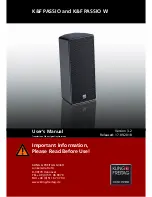
Crossover
-
DSP Settings –
The crossover knob selects both the crossover frequency and also lets you
select from two DSP sound modes. If the knob is turned fully counterclockwise until it clicks (LFE
enabled), the internal crossover of the Speedwoofer is bypassed and the crossover function will be
handled by your home theater receiver or processor. Also, with the Speedwoofer
’
s
crossover bypassed, the DSP mode will extend the Speedwoofer
’
s bass response, which can be ideal
for movies.
If the knob is rotated clockwise off the bypass position, the Speedwoofer
’
s crossover is active, and
you can select the appropriate frequency. For example, an 80Hz setting means your Speedwoofer
will handle all frequencies at 80Hz and below. An 80Hz setting is recommended for larger
bookshelf speakers. For smaller bookshelf speakers, we recommend a setting of 90
-
100Hz. We also
suggest trying different crossover settings so that the Speedwoofer integrates seamlessly with the
rest of your system.
When the internal crossover is active, the DSP will enable your Speedwoofer to deliver the same
performance as our original Speedwoofer 10S. This may be a good choice if you primarily listen to
music or if you wish to limit the bass that is transmitted to other rooms. To use this mode with your
home theater receiver
’
s internal crossover also active, turn the crossover knob fully
clockwise. This will prevent the Speedwoofer
’
s crossover from interfering with your home theater
receiver
’
s crossover.
Phase
-
Allows you to align the bass through subwoofer so it blends perfectly with the rest of the
speakers. In addition, the phase should be adjusted so that the output in your room is
maximum at the crossover frequency. If you
’
re a bit techy, this can be determined using a sound
level meter or a sound meter smartphone application and a pure tone that corresponds to the
crossover frequency. The standard setting is 0 degrees, but some experimentation may be
needed.
Line In/LFE In
-
LFE stands for low frequency effects. This is where the Speedwoofer receives the
bass signal from your receiver or amplifier. For home theater, use a single RCA cable from the
receiver's subwoofer or LFE output to the Speedwoofer's LFE in. For a two channel stereo system,
use a stereo pair of RCA cables to the Speedwoofer's Line inputs.
Line Out
-
For a two channel system, this feeds the signal back to the amplifier for your other
speakers. The Line Outs can also be used to connect an additional Speedwoofer. See the Dual
Speedwoofer section.
Speaker Level In
-
This connection can be used in stereo systems with amplifiers that do not have
pre
-
amplifier outputs. Please refer to the instructions at the top of page 13. Do not use this
connection if you
’
ve already connected the Speedwoofer using any of the other methods.
Ground
-
In the unlikely event there is hum or noise when using the speaker level in connections,
the ground connection can be used to ground the Speedwoofer to your other components. Please
see the section on ground loop hum or noise on the next page.
Input Voltage
-
Fuse
-
Is Normally set for use in the U.S. and Canada at 115 Volts
. If your country's
voltage is 230
-
240 Volts, you must change this setting before using the Speedwoofer. You must
also change the fuse to a 2.5 amp fuse. The fuse location is just below the AC receptacle on the
back of the subwoofer. Unfortunately, failure to do this will void your warranty.
Main Power Switch
-
Auto Power Switch
-
The power switch will normally be left on. When
switched on, and the auto/on switch is set to on, your Speedwoofer will go into standby mode (red
light) until it receives an audio signal and then it will turn green. With no signal, it will return to
standby mode after approximately 20 minutes. When the auto power switch is set to off, the
Speedwoofer will always stay in operation mode (but consumes very little power, even at this
setting). When connecting and disconnecting cables to the Speedwoofer, make sure the main power
switch is off.
17



































